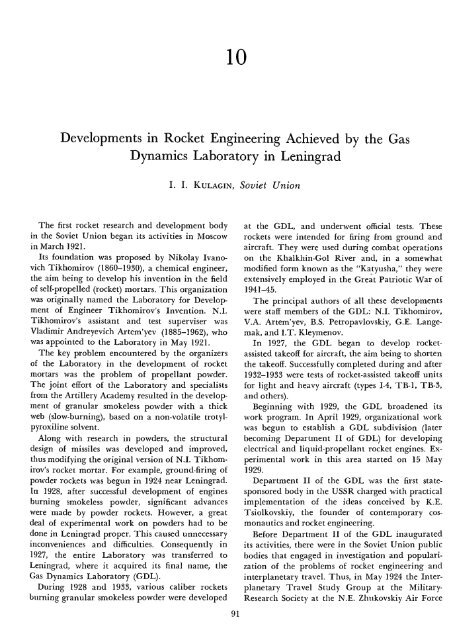FIRST STEPS TOWARD SPACE - Smithsonian Institution Libraries
FIRST STEPS TOWARD SPACE - Smithsonian Institution Libraries
FIRST STEPS TOWARD SPACE - Smithsonian Institution Libraries
Create successful ePaper yourself
Turn your PDF publications into a flip-book with our unique Google optimized e-Paper software.
10<br />
Developments in Rocket Engineering Achieved by the Gas<br />
Dynamics Laboratory in Leningrad<br />
The first rocket research and development body<br />
in the Soviet Union began its activities in Moscow<br />
in March 1921.<br />
Its foundation was proposed by Nikolay Ivanovich<br />
Tikhomirov (1860-1930), a chemical engineer,<br />
the aim being to develop his invention in the field<br />
of self-propelled (rocket) mortars. This organization<br />
was originally named the Laboratory for Development<br />
of Engineer Tikhomirov's Invention. N.I.<br />
Tikhomirov's assistant and test superviser was<br />
Vladimir Andreyevich Artem'yev (1885-1962), who<br />
was appointed to the Laboratory in May 1921.<br />
The key problem encountered by the organizers<br />
of the Laboratory in the development of rocket<br />
mortars was the problem of propellant powder.<br />
The joint effort of the Laboratory and specialists<br />
from the Artillery Academy resulted in the development<br />
of granular smokeless powder with a thick<br />
web (slow-burning), based on a non-volatile trotylpyroxiline<br />
solvent.<br />
Along with research in powders, the structural<br />
design of missiles was developed and improved,<br />
thus modifying the original version of N.I. Tikhomirov's<br />
rocket mortar. For example, ground-firing of<br />
powder rockets was begun in 1924 near Leningrad.<br />
In 1928, after successful development of engines<br />
burning smokeless powder, significant advances<br />
were made by powder rockets. However, a great<br />
deal of experimental work on powders had to be<br />
done in Leningrad proper. This caused unnecessary<br />
inconveniences and difficulties. Consequently in<br />
1927, the entire Laboratory was transferred to<br />
Leningrad, where it acquired its final name, the<br />
Gas Dynamics Laboratory (GDL).<br />
During 1928 and 1933, various caliber rockets<br />
burning granular smokeless powder were developed<br />
I. I. KULAGIN, Soviet Unioi<br />
91<br />
at the GDL, and underwent official tests. These<br />
rockets were intended for firing from ground and<br />
aircraft. They were used during combat operations<br />
on the Khalkhin-Gol River and, in a somewhat<br />
modified form known as the "Katyusha," they were<br />
extensively employed in the Great Patriotic War of<br />
1941-45.<br />
The principal authors of all these developments<br />
were staff members of the GDL: N.I. Tikhomirov,<br />
V.A. Artem'yev, B.S. Petropavlovskiy, G.E. Langemak,<br />
and I.T. Kleymenov.<br />
In 1927, the GDL began to develop rocketassisted<br />
takeoff for aircraft, the aim being to shorten<br />
the takeoff. Successfully completed during and after<br />
1932-1933 were tests of rocket-assisted takeoff units<br />
for light and heavy aircraft (types 1-4, TB-1, TB-3,<br />
and others).<br />
Beginning with 1929, the GDL broadened its<br />
work program. In April 1929, organizational work<br />
was begun to establish a GDL subdivision (later<br />
becoming Department II of GDL) for developing<br />
electrical and liquid-propellant rocket engines. Experimental<br />
work in this area started on 15 May<br />
1929.<br />
Department II of the GDL was the first statesponsored<br />
body in the USSR charged with practical<br />
implementation of the ideas conceived by K.E.<br />
Tsiolkovskiy, the founder of contemporary cosmonautics<br />
and rocket engineering.<br />
Before Department II of the GDL inaugurated<br />
its activities, there were in the Soviet Union public<br />
bodies that engaged in investigation and popularization<br />
of the problems of rocket engineering and<br />
interplanetary travel. Thus, in May 1924 the Interplanetary<br />
Travel Study Group at the Military-<br />
Research Society at the N.E. Zhukovskiy Air Force

















